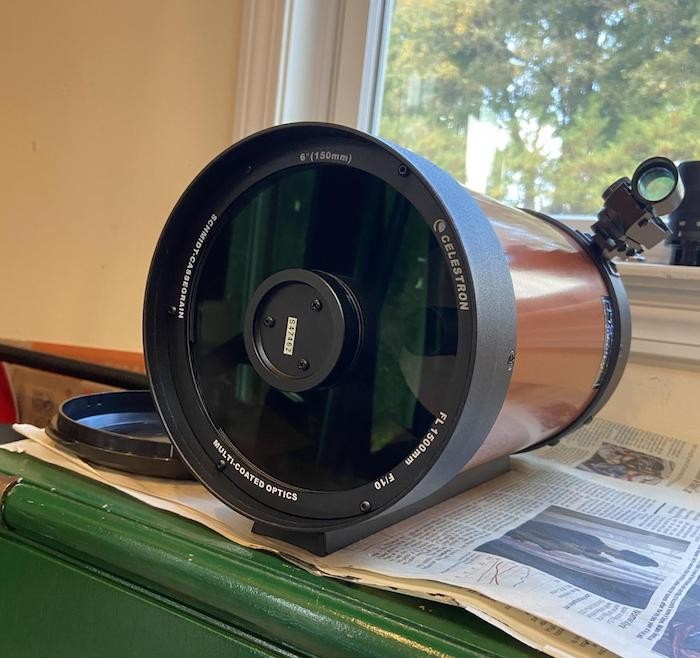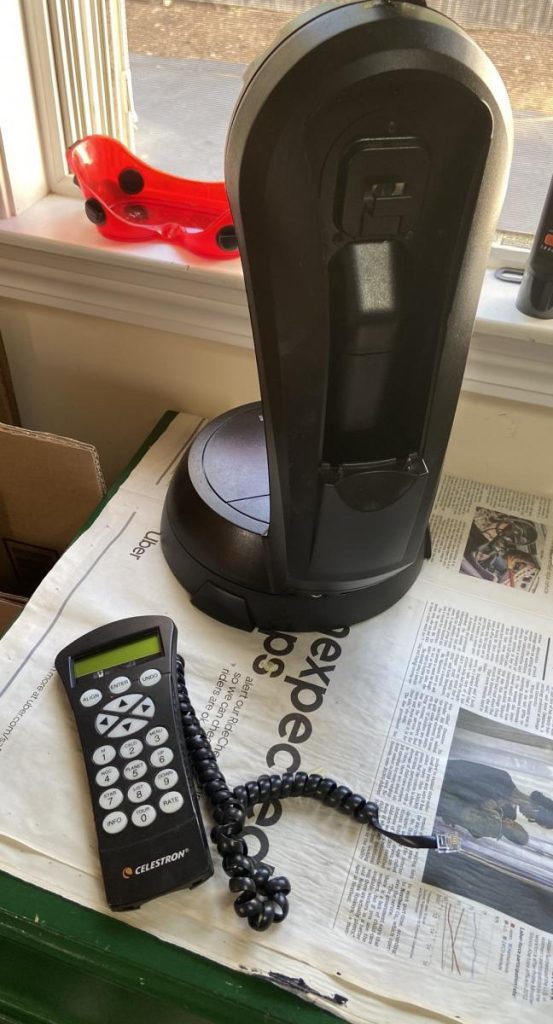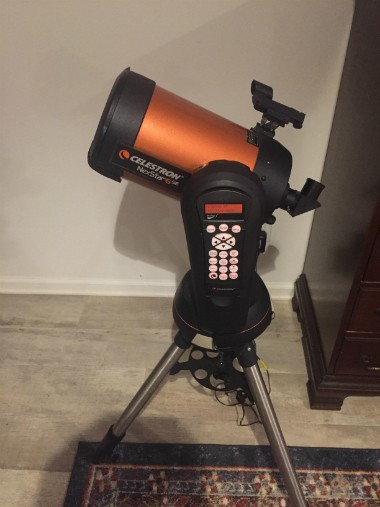The NexStar 6SE’s C6 Optical Tube

The Celestron NexStar 6SE’s optical tube is an orange version of the C6, Celestron’s popular 6″ Schmidt Cassegrain, which has an actual aperture of 150 mm (6-inch) and focal length of 1,500 mm, giving it a focal ratio of f/10, which is typical of most SCTs.
Being out in 2006, the C6 is the newest of Celestron’s SCT models. The C5, C8, and C14 were made in 1970, and the C11 and C9.25 were made in 1977 and 1993, respectively. Celestron has long turned out some of the best optics in its price class, setting the standards for SCTs back in the 60’s and 70’s. Their SCTs are still hard to beat, and with the closure of Meade, Celestron is the only player in the SCT field.
The C6 offers significantly more light-gathering ability and resolution than its smaller C5 sibling, and is a favorite among experienced astronomers (including myself) as a “grab n’ go” telescope. It provides a good balance between light gathering capability, magnification, size, weight, and cost.
Thanks to its small primary mirror size, the C6 doesn’t really suffer from the mirror flop problems (a shifting of the primary mirror that can cause the image to blur) that plague larger Schmidt-Cassegrains nor does it have a particularly narrow field of view.
That being said, despite being physically compatible with a 2” diagonal, the C6 cannot actually fully illuminate the field of view when I use a 2” low-power eyepiece and vignettes (a reduction in brightness around the edges of the image) quite badly if I use a f/6.3 reducer, an accessory that widens the field of view for astrophotography purposes.
As a result, the scope isn’t going to provide a field of view much larger than 1 degree (about 2 full moons), which means it isn’t ideal for wide-field vistas of star clusters and nebulae. Nonetheless, a 1-degree field is still plenty big to satisfy most users.
A Note on HyperStar Compatibility
The C6 also has HyperStar compatibility.
This means that with Starizona’s Hyperstar corrector, I can remove the secondary mirror and stick the Hyperstar in its place at the front of the telescope. This enables me to image with a CCD or CMOS camera at a focal ratio of just f/2 instead of the telescope’s inherent f/10 focal ratio. However, what I don’t like is that the C6 only works with relatively small sensors in its Hyperstar configuration, both due to the physical constraints of the design and the risk that a large camera housing obstructs most of the telescope’s aperture.
Additionally, a HyperStar costs more than the entire telescope. I see more effectiveness if the C6 can be mounted on a German equatorial mount rather than an alt-azimuth like the NexStar SE.
Collimation Requirements
Being a Schmidt-Cassegrain, the C6 does need to be collimated from time to time.
Contrary to what some folks might tell you, this is not a particularly scary or difficult process and absolutely does not require sending it back to Celestron! You simply adjust 3 small screws on the secondary mirror housing while pointed at a bright star—it’s arguably easier than collimating a Newtonian.
Check out our collimation guide for more information.
However, I’d warn you not to buy the oft-advertised “Bob’s Knobs” or thumbscrew collimation knobs for the 6SE. They’re overpriced and counterintuitively cause the telescope to go out of collimation more often due to the insufficient torque they exert to keep the secondary secured tightly.
The Eyepiece and Red Dot Finder with 6SE
The 6SE comes with a single eyepiece, a 25mm E-Lux Plossl providing 60x. It is among the lower-end eyepieces Celestron sells, even though its a good starter eyepiece for low magnification. As with any telescope, I think the NexStar 6SE really could use a few extra eyepieces.
For starters, I’d recommend the beloved 6mm “goldline” for 250x, a fairly high but still reasonable magnification for the Moon, planets, and double stars. For moderate magnification, from my experience, a 15mm goldline or 15mm Agena Starguider, either of which will provide 100x, is a good choice. Various other eyepieces at focal lengths in between these would also be good, but I’d recommend just two to start, along with, of course, the included 25mm Plossl.
Like most GoTo telescopes, the 6SE also comes with a simple red dot sight to complete the initial alignment before it can automatically slew itself around the sky.
Nexstar 6SE Mount Capabilities
The 6SE and 8SE both use a larger version of the NexStar SE mount with a tall, single-arm fork and a rather robust steel tripod with 1.75” legs.
The mount for the 6SE weighs in at only 11 lbs and the tripod weighs 9 lbs. The whole telescope package comes in at under 40 lbs and can be broken down into very manageable components. This makes it convenient for transport or for people who don’t want to haul a large scope up and down the stairs of an apartment building.
Unlike the smaller mounts sold with the 4SE and 5SE, the 6/8SE mount does not come with a built-in wedge. The loss of this feature is not especially relevant, as I’ve realized that it is little more than a useless gimmick on those telescopes.

The NexStar SE mount uses the same NexStar+ hand controller supplied with most of Celestron’s computerized telescopes. It looks pretty much like a pocket calculator. To use it, you enter your location, time, and date, point the telescope at two or three reference stars, and off you go. The whole process takes about 10 minutes from start to finish.
Once the telescope is aligned, you can choose from lists of deep-sky objects, the planets, and double stars to point it at, which it’ll slew to automatically with high accuracy, assuming you’ve aligned it properly. However, getting the initial alignment to work can be challenging for some beginners, and the NexStar controller makes no indication of where in the sky your targets are or what is visible.
The GoTo accuracy is fairly good for an alt-az mount, and it can usually put the desired object in the field of view (whether or not you can actually see it depends on the sky conditions and the object). As with any alt-az GoTo mount, I recommend regular re-synching to maintain GoTo accuracy.
Additionally, most of the objects available in its catalogs are too faint for the C6 to reveal, and its “40,000 objects” claim is mostly due to the fact that it features tens of thousands of SAO-designated stars. You’re basically limited to the solar system, the Messier catalog, and many of the brighter NGC objects.
The Downsides?
The mechanics of the mount are generally functional, but they don’t always hold up to heavy use. NexStar SE mount’s listed weight capacity is 12 lbs. The OTA itself weighs 8. This leaves 4 lbs. for additional payload such as diagonal, eyepiece, and finder. This is sufficient for casual use, but users who want to use higher-end—and often heavier—eyepieces start pushing the limits. And those who attempt to add a camera can be pushing things right to the limits. The same mount is used for the NexStar 8SE, and this is a real problem, as the 8SE itself weighs 12 lbs.
Repairs to the mount can be expensive, often costing a significant portion of the original price. And let me be clear on this: if the mount stops working, ether mechanically or electronically, there is no manual backup.
You could unlock the catches on both altitude and azimuth axes and manually move the mount. Moving the azimuth axis isn’t a problem. But the altitude axis is—the OTA will just flop around unless you hold it in position, and that just doesn’t really work well. So, if the mount breaks down, until it’s fixed, you have a fairly expensive conversation piece or closet filler.
Celestron has proven they can do better. The NexStar Evolution line is significantly better—as you would expect with the increased price.
If you can afford the Evolution, it’s the better buy. If not, you might still consider a 6 or 8 inch Dob instead.
Should I buy a Used NexStar 6SE?
If the price is right, go for it. Make sure that the telescope powers on and slews correctly, and that the interior of the telescope is clean.
Alternative Recommendations
The 6SE is just about the pinnacle of computerized (and indeed, non-Dob) telescopes under $1000, so if you’re looking for an alternative, the only thing we’d recommend in its place would probably be a Dobsonian. Here are some of the best options:
Under $1000
- The Apertura AD10/Zhumell Z10/Orion SkyLine 10 offers 2.8 times as much light collecting power and just under double the resolution of the NexStar 6SE, mounted atop a simple and easy-to-aim Dobsonian mount that sets up in seconds and with a variety of high-quality features and accessories like a built-in 2” dual-speed Crayford focuser and cooling fan, along with a 9×50 right-angle finder, laser collimator, and 2” wide-angle eyepiece. It’s got nearly unprecedented value for the money and the views will knock your socks off.
- The Apertura AD8/Zhumell Z8/Orion SkyLine 8 is a similarly great bargain to the larger AD10/Z10, though if you can afford the larger of the two models, you’ll be rewarded greatly as the overall weight and bulk difference between a 10” and 8” is nearly immaterial.
- The Explore Scientific 10” Hybrid Dobsonian offers a lot of aperture for the money in a compact and easily collapsed package with high-quality fittings. However, besides the telescope itself, you basically get nothing – the provided 2” focuser is a simple single-speed Crayford unit, the included red dot finder and eyepiece are almost unusable and the telescope needs a shroud to keep light out of the optical tube – along with a new finder and at least a couple of new eyepieces to go with it. When dismantled, the 10” Hybrid takes up hardly any more space than the 6SE and its tripod, and it is easy to put together and be observing faster than it takes to get the 6SE’s tripod leveled and the mount done with a 2-star GoTo alignment.
- The Sky-Watcher Virtuoso GTi 150P features full motorized tracking and GoTo like the 6SE, and its tabletop Dobsonian mount and collapsible optical tube take up about as much space as the 6SE optical tube and mount head, thus opening up the possibility of a carry case or backpack and airline travel. You do need a steady surface to set it on, but if you can accommodate that need, you’ll be rewarded with a wider field of view than the 6SE can achieve with the ability to aim the telescope entirely manually as well as control its mount via your smartphone/tablet instead of an old-fashioned hand set controller. The Virtuoso GTi 150P is also available in an all-manual configuration as the Heritage 150P from Sky-Watcher.
- The Celestron Astro Fi 130 has a smaller aperture than the 6SE, but its vastly shorter focal length and the ability to take 2” eyepieces allow you to achieve a much wider field of view, which is ideal for viewing deep-sky objects. The Astro Fi mount is also controlled via your smartphone or tablet rather than a hand controller. The optics are the same as those in the Virtuoso GTi/Heritage 130P tabletop Dobsonian.
Aftermarket Accessory Recommendations
The 6SE also benefits significantly from a dew shield. In addition to delaying the formation of dew or frost on your front corrector lens, the dew shield helps block stray light from entering the telescope tube and reducing contrast.
The last accessory we’d like to recommend is the Celestron SkyPortal Wi-Fi Module. It replaces the antiquated included hand controller by connecting the telescope to your smartphone or tablet, allowing you to align and control the 6SE with Celestron’s free SkyPortal app or the vastly superior SkySafari app.
What can you see with the Celestron NexStar 6SE?
Within the solar system, the Celestron Nexstar 6SE can do a lot. Expect to see the following:
- Mercury & Venus: Phases
- The Moon has a ridiculous amount of detail, with features as small as a mile visible. I could go and write paragraphs about how great the views of the Moon are with the 6SE, or arguably any decent telescope. But I couldn’t possibly do it justice, so I’ll let the views speak for themselves.
- Mars: The ice caps are fairly obvious, even when Mars is far from Earth. Around opposition, you can see a bunch of darkly shaded areas, which are just duller colored sand.
- Jupiter: The cloud bands and Great Red Spot look great. With good sight, I can pick out mottled details and ripples within the cloud bands and the brownish polar zones. Jupiter’s 4 large moons are especially obvious as disks when they eclipse and transit the planet.
- Saturn’s rings are easily visible, as is the Cassini Division within them, the latter provided I have good sight. Around half a dozen moons can be spotted, along with faint variations in the tones of Saturn’s cloud bands. Saturn’s largest moon, Titan, is visibly not a star and appears a slightly gold color.
- Uranus – A small turquoise dot. The moons are out of reach of anything under 10 inches in aperture.
- Neptune – A near-stellar blue dot. Its largest moon, Triton, can just barely be glimpsed under dark and steady skies.
Outside the Solar System, the NexStar 6SE is a solid performer, albeit limited somewhat by its aperture and field of view.
You can expect to see a lot of open star clusters like M35, M11, and M67. Some large clusters, like the Pleiades (M45) and Beehive (M44), cannot fit into the field of view with the 6SE, though they can still be enjoyed. The bright globular star clusters such as M13, M15, and M22 are kind of resolved with 6 inches of aperture—though barely—and only with fairly decent skies. Smaller globulars will remain fuzzy patches of light.
The few bright emission nebulae that dot our skies look magnificent in the 6SE, particularly if I use a good UHC nebula filter on them. The Trapezium star cluster’s fainter members, nestled within the heart of the Orion Nebula, are an easy catch. Planetary nebulae look decent with the 6SE, and some begin to show teal or blue coloration.
The 6SE’s aperture is enough to start showing me a fair number of galaxies, but I won’t see detail unless I are under truly dark skies. With dark skies, however, galaxies start to come alive. M51’s spiral arms can be vaguely glimpsed, as can the dust lanes in M82, M64, and M31. M33, M63, and M101 may also reveal faint spiral arms.
The Celestron NexStar 6SE is also a fantastic double star splitting scope, especially thanks to its lack of diffraction spikes from spider vanes that a Newtonian reflector typically suffers from. Sub-arcsecond doubles are possible with good seeing conditions.




Nice telescope. Came with faulty red dot spotting scope. Called the company. They sent a replacement
I’d like to suggest adding the Celestron SkySync GPS Accessory to your list of recommended aftermarket accessories. It has really cut the required time and improved the accuracy of the alignment process.
It’s also more expensive than a nice eyepiece, making it a complete rip-off when your smartphone has all of the necessary information available.